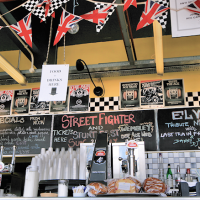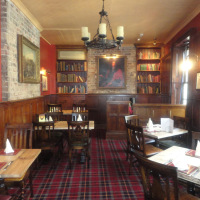Highgate Cemetery & Nature Reserve
In north London, Highgate Cemetery is both a resting place for over 170,000 in 53,000 graves, but it is also a significant nature reserve. Those resting here range from Karl Marx to George Eliot to Charles Dickens’ family. More recently Alexander Litvinenko was buried here - in a lead coffin to stop his radioactive remains from harming anybody else! Other notable burials include many actors (including Ralph Richardson), authors, and many artists including Topolski and Lucien Freud. The cemetery is divided into ‘East’ and ‘West’. The East still conducts burials and is open for self-guided map tours while the West requires a tour guide. Tour hours and availability vary a lot, so check their website before going: www.highgate-cemetery.org
The West Cemetery opened in 1839 and contains grand sweeps of mausoleums known as the Circle of Lebanon and the Egyptian Walk. The East Cemetery was added in 1854 and contains many small paths to explore, weathered tombs, dark canopies of trees, and ivy covered memorials. The visual look of Highgate has influenced many individuals perceptions of what a rustic cemetery should look like as it has appeared in many films and photographs given its gothic aesthetic.
Highgate’s history resulted from London’s rapid population growth in the early 1800s. At that time, only one million people lived in London, but the population was growing rapidly and Parliament passed a statute to create seven new private cemeteries in the countryside to handle the growing need. These cemeteries were Kensal Green (1833), West Norwood (1836), Highgate (1839), Abney Park (1840), Brompton (1840), Nunhead (1840) and Tower Hamlets (1841).
Highgate Cemetery started as 17 acres of land from the former Ashurst House - with 15 acres for members of the Church of England and 2 acres for ‘dissenters’. Chapels for each parcel were housed within one Tudor-style building. Over the next twenty years became one of the capital’s most fashionable cemeteries. In 1854 the it was so profitable that it was extended by 20 acres on the other side of its Swain’s Lane site. This “East” cemetery was opened in 1856. A tunnel beneath Swain’s Lane connected the new ground with the Church of England chapel in the older (West) side. With the aid of a hydraulic lift, coffins would descend into the tunnel and remain on cemetery ground for their journey to the other side. Unarguably, Karl Marx (1883) is the most famous resident of Highgate Cemetery in the East Cemetery and it is likely the most visited grave in London. Over the years, the families owning burial rights died out, and cheaper alternatives became available. After WWII the cemetery was neglected and fell into disrepair. By 1975 the operator ran out of funds and closed the gates. A non-profit group - The Friends of Highgate Cemetery - formed that same year to save the cemetery for grave owners, public benefit and future generations. Since then years of restoration and conservation work has been carried out on the burial sites, terraces and stonework.
Because of the years of neglect the land became a haven for wildlife and a place of unique flora and fauna. But with the attention now afforded it the cemetery has achieved a unique balance between being a place of remembrance and natural beauty. In 1987, the Cemetery was added to the English Heritage Register of Parks and Gardens of Special Historic Interest (upgraded to Grade I in 2009). Wild flowers, ferns and mosses can be seen everywhere at most times of the year, and over forty species of birdlife frequent the cemetery – many of those nesting here year after year - including owls and woodpeckers. It is also home to many foxes and badgers, and periodic evening walks occur to view the resident bats. In spring/summer, 20 species of butterfly can be seen, including the unique Holly Blue.
Located at: Swains Lane, Highgate, N6 6PJ
Closest tube: Archway
One comment on “Highgate Cemetery & Nature Reserve”
Leave a Reply
Recommended reading
- Migliori Casino Online
- Casino Non Aams Italia
- Casinos Not On Gamstop
- UK Online Casinos Not On Gamstop
- Casino Sites Not On Gamstop
- Casino Sites Not On Gamstop
- Non Gamstop Casino
- Casinos Not On Gamstop
- Non Gamstop Casinos UK
- Best Non Gamstop Casinos
- Meilleur Casino En Ligne France
- Non-gamstop UK Casinos
- UK Gambling Sites Not On Gamstop
- Casino Sites In UK
- Casinos Not On Gamstop
- Non Gamstop Casinos
- Sites Not On Gamstop
- Meilleur Site De Casino En Ligne
- Casino En Ligne Fiable
- Non Gamstop Casinos
- UK Betting Sites
- Non Gamstop Casino Sites UK
- Non Gamstop Casino UK
- Casino Online Non Aams
- Casino Non Aams Sicuri





Pingback: Grant Museum of Zoology ~ one of London’s fascinating small museums. | London Unveiled